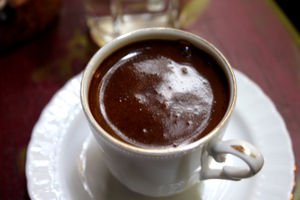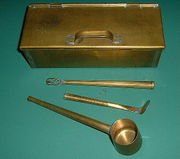Turkish Coffee
DDV CULINARY

A cup of Turkish coffee served at an Istanbul terrace
Turkish coffee (Turkish: Türk kahvesi ),is a specific way of preparing coffee. It is common throughout the Middle East, North Africa and Balkan countries. This method of preparation is believed to have originated in Damascus and to have become widespread during the Ottoman - hence the eventual appelation 'Turkish coffee'. In Turkey, it was known simply as "coffee" (kahve) until instant coffee was brought in during the 1980s. Today younger generations refer to the beverage as "Turkish coffee" (Türk kahvesi). In Armenian communities, it is referred to as surj. It was also traditionally called Turkish coffee in Greece and Cyprus (tourkikos kafes), but the name was changed following the 1974 Turkish intervention/invasion of Cyprus and replaced with the term "Greek coffee" (ellinikos kafes or kypriakos kafes) - though the ingredients and its appreciation remain the same. In Bosnian, Croatian and Serbian communities, this type of coffee is referred to as Bosanska Kafa or simply "coffee". Coffee culture is highly developed in the Balkans region, where Turkish coffee is the dominant method of preparation. It also remains a traditional beverage in Greek, Cypriot and Turkish restaurants around the world. The necessary equipment to prepare Turkish coffee consists of a narrow-topped small boiling pot called cezve or džezva, a teaspoon and a heating apparatus. The ingredients are finely ground coffee, cold water and (if desired) sugar. It is served in cups (fincan or fildžan) similar in size to Italian espresso or Japanese sake cups. Some modern cups do have handles. Traditional cups did not, and coffee was drunk either by handling the cup with the tip of the fingers or, more often, by placing the cup in a zarf, a metal container with a handle. Traditionally, the pot is made of copper and has a wooden handle. The size of the pot is chosen to be close to the total volume of the cups to be prepared, since using a too large pot results in most of the precious foam sticking to the inside of it. Also, a certain depth of water is necessary for the coffee particles to sink. The teaspoon is used both for stirring and measuring the amount of coffee and sugar. Note that the teaspoons in the United States are much larger than the teaspoons in countries where Turkish coffee is common. The dipping parts of the teaspoons in these countries are about 1 cm long and 0.5 cm wide. For heating, an ordinary stove burner is sufficient, but too strong of a heat source is undesirable, as the brewing time needs to be at least five minutes. After this general description, personal brewing preferences vary. Below is one example. As with other ways of preparing coffee, the best Turkish coffee is made from freshly roasted beans ground just before brewing. A dark roast is preferable but even a medium roast coffee will yield a strong aroma and flavour. The grinding is done either by pounding in a mortar (the authentic method) or using a mill (the more usual method today), and the end result is a fine coffee powder. Beans for Turkish coffee are ground even finer than the grind used in pump-driven espresso makers, therefore, Turkish coffee should be powdery. It is the finest grind of coffee used in any style of coffee making. For best coffee, the water needs to be cold. Due to this, if sugar is desired, an easily dissolvable form should be chosen. 
Utensils to prepare Turkish coffee (handmade from Crete)
The amount of water necessary can be measured using the cups. The coffee and the sugar are usually added to water, rather than being put into the pot first. For each cup between one and two heaped teaspoons of coffee are used. In Turkey, four degrees of sweetness are used. The Turkish terms and approximate amounts are as follows: sade (plain; no sugar), az şekerli (little sugar; half a levelled teaspoon of sugar), orta şekerli (medium sugar; one levelled teaspoon), and çok şekerli (a lot of sugar; one and a half or two levelled teaspoons). The coffee and the desired amount of sugar are stirred until all coffee sinks and the sugar is dissolved. Following this, the spoon is removed and the pot is put on the fire. No stirring is done beyond this point, as it would dissolve the foam. Just as the coffee begins boiling, the pot is removed from the fire and the coffee is poured into the cups. A well-prepared Turkish coffee has a thick foam at the top, is homogeneous, and does not contain noticeable particles in the foam or the liquid. This can be achieved only if cold water and a low heat are used. Starting with warm water or a strong heat does not leave enough time for either the coffee to sink or the foam to form. It is possible to wait an additional twenty seconds past boiling, which makes a homogeneous and delicious coffee, but the foam is completely lost. To overcome this, foam can be removed and put into cups earlier and the rest can be left to boil. In this case special attention must be paid to transfer only the foam and not the suspended particles. All the coffee in the pot is poured into cups, but not all of it is drunk. The thick layer of sludgy grounds at the bottom of the cup is left behind. The cup is then commonly turned over into the saucer to cool, and then the patterns of the coffee grounds can be used for a kind of fortune telling called tasseography, or tasseomancy (kafemandeia in Greek). These terms also refer to the reading of tea leaves. There are other schools of preparing Turkish coffee that vary from the above. One such method involves starting with hot water alone, then adding and dissolving the sugar. The product is in essence a sugar syrup, with a higher boiling point than water. The coffee and cardamom are added, and the mixture is stirred. It is then brought to a boil and just before serving is removed from the heat for a few seconds and returned to it, being brought to a brief boil a second time. This double (and sometimes triple) boiling is an essential part of the process, both ceremonially and—as connoissieurs claim—on the palate. Turkish coffee is drunk slowly and is usually served with a glass of cold water (to refreshen the mouth to better taste the coffee before sipping), though sometimes, especially after dinner, with a small glass of mint liqueur. Turkish coffee grounds are sometimes flavoured with cardamom, eliminating the need to have it added during preparation. This article is licensed under the GNU Free Document LicenseIt uses material from Wikipedia. |